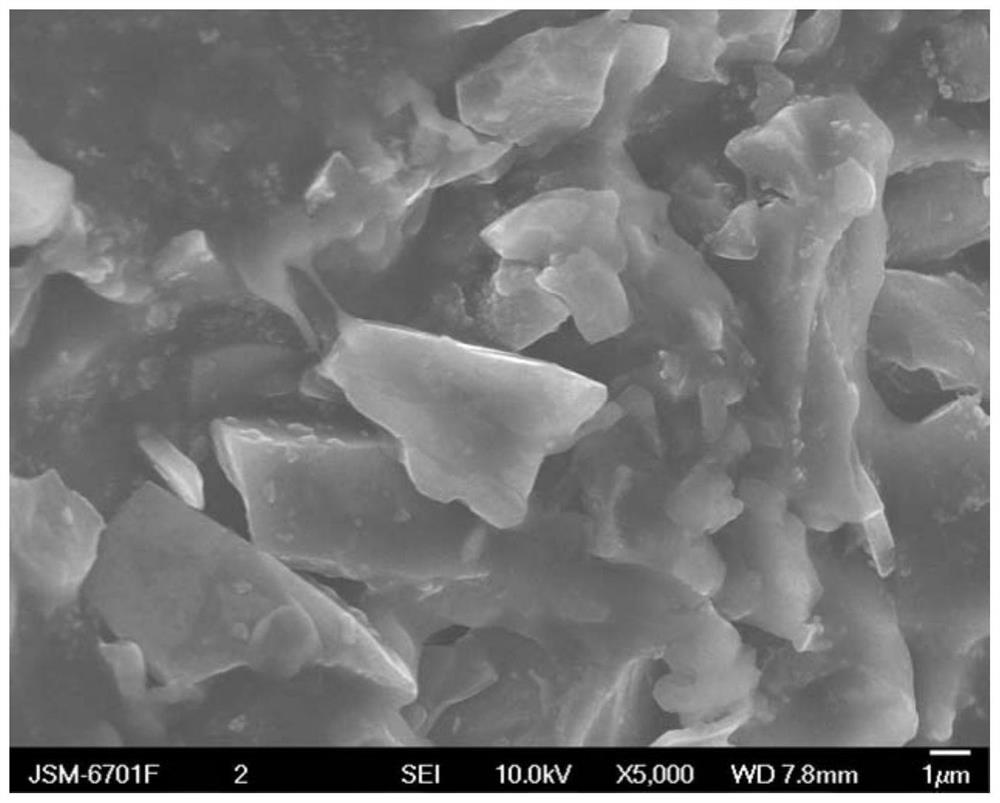Hard carbon material and preparation method and application thereof
A hard carbon and pre-oxidation technology, which is applied in the preparation/purification of carbon, electrical components, electrochemical generators, etc., can solve the problems of poor cycle stability, low first-cycle coulombic efficiency, and low reversible specific capacity, and achieve mild conditions Controllable, conducive to diffusion and transport, and increase the effect of specific surface area
- Summary
- Abstract
- Description
- Claims
- Application Information
AI Technical Summary
Problems solved by technology
Method used
Image
Examples
Embodiment 1
[0047] (1) phenolic resin pretreatment: get 10g phenolic resin (specific surface area 2m 2 / g) was completely dissolved in absolute ethanol, added conductive carbon black with 5wt% of phenolic resin and stirred for 2 hours, and then placed in an oven at 70° C. for 12 hours to obtain the treated phenolic resin.
[0048] (2) Pre-oxidation treatment: 5g of the treated phenolic resin was first heated to 200°C for 1 hour at a heating rate of 12°C / min in an air atmosphere, and then heated to 300°C for 1 hour at a heating rate of 8°C / min. Finally, the temperature was raised to 400° C. at a heating rate of 5° C. / min, and calcined for 0.5 h.
[0049] (3) Cooling: the pre-oxidized particles were rapidly cooled to 150°C at 20°C / min, kept for 20 seconds, and then naturally cooled to 30°C.
[0050] (4) Carbonization: After taking it out, the particles are ball-milled into powder, and the obtained powder is put into a tube furnace, and carbonized at 1250°C for 6 hours in a 20% Ar / N2 atmosp...
Embodiment 2
[0053] (1) phenolic resin pretreatment: get 10g phenolic resin (specific surface area 2m 2 / g) was completely dissolved in absolute ethanol, added conductive carbon black with 5wt% of phenolic resin and stirred for 2 hours, and then placed in an oven at 70° C. for 12 hours to obtain the treated phenolic resin.
[0054] (2) Pre-oxidation treatment: 5g of the treated phenolic resin was first heated to 250°C for 2 hours at a heating rate of 15°C / min in an air atmosphere, and then heated to 350°C for 2 hours at a heating rate of 10°C / min. Finally, the temperature was raised to 450° C. at a heating rate of 7° C. / min, and calcined for 1 hour.
[0055] (3) Cooling: the pre-oxidized particles were rapidly cooled to 150°C at 20°C / min, kept for 20 seconds, and then naturally cooled to 30°C.
[0056] (4) Carbonization: after taking out, ball mill the particles into powder, put the obtained powder into a tube furnace, carbonize at 1200°C for 6 hours in a 20% Ar / N2 atmosphere at a heating...
Embodiment 3
[0059] (1) phenolic resin pretreatment: get 10g phenolic resin (specific surface area 2m 2 / g) was completely dissolved in absolute ethanol, added conductive carbon black with 5wt% of phenolic resin and stirred for 2 hours, and then placed in an oven at 70° C. for 12 hours to obtain the treated phenolic resin.
[0060] (2) Pre-oxidation treatment: 5g of the treated phenolic resin was first heated to 200°C for 1 hour at a heating rate of 11°C / min in an air atmosphere, and then heated to 300°C at a heating rate of 9°C / min for 2 hours. Finally, the temperature was raised to 400° C. at a heating rate of 5° C. / min, and calcined for 1 h.
[0061] (3) Cooling: the pre-oxidized particles were rapidly cooled to 150°C at 20°C / min, kept for 20 seconds, and then naturally cooled to 30°C.
[0062] (4) Carbonization: After taking it out, the particles are ball-milled into powder, and the obtained powder is put into a tube furnace, and carbonized at 1300°C for 6 hours in a 20% Ar / N2 atmosph...
PUM
| Property | Measurement | Unit |
|---|---|---|
| Current density | aaaaa | aaaaa |
| Inverse capacity | aaaaa | aaaaa |
Abstract
Description
Claims
Application Information
 Login to View More
Login to View More - R&D
- Intellectual Property
- Life Sciences
- Materials
- Tech Scout
- Unparalleled Data Quality
- Higher Quality Content
- 60% Fewer Hallucinations
Browse by: Latest US Patents, China's latest patents, Technical Efficacy Thesaurus, Application Domain, Technology Topic, Popular Technical Reports.
© 2025 PatSnap. All rights reserved.Legal|Privacy policy|Modern Slavery Act Transparency Statement|Sitemap|About US| Contact US: help@patsnap.com



